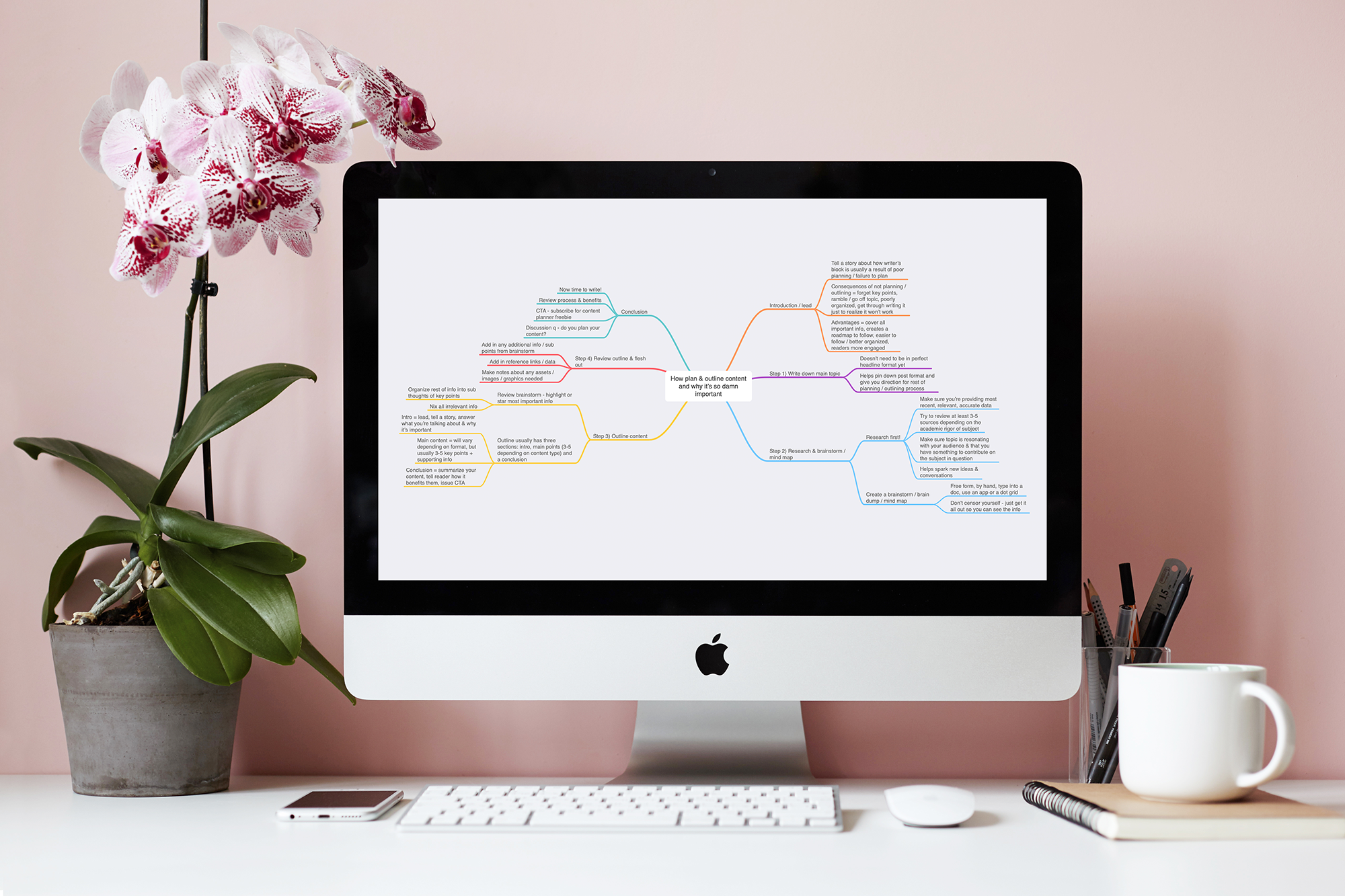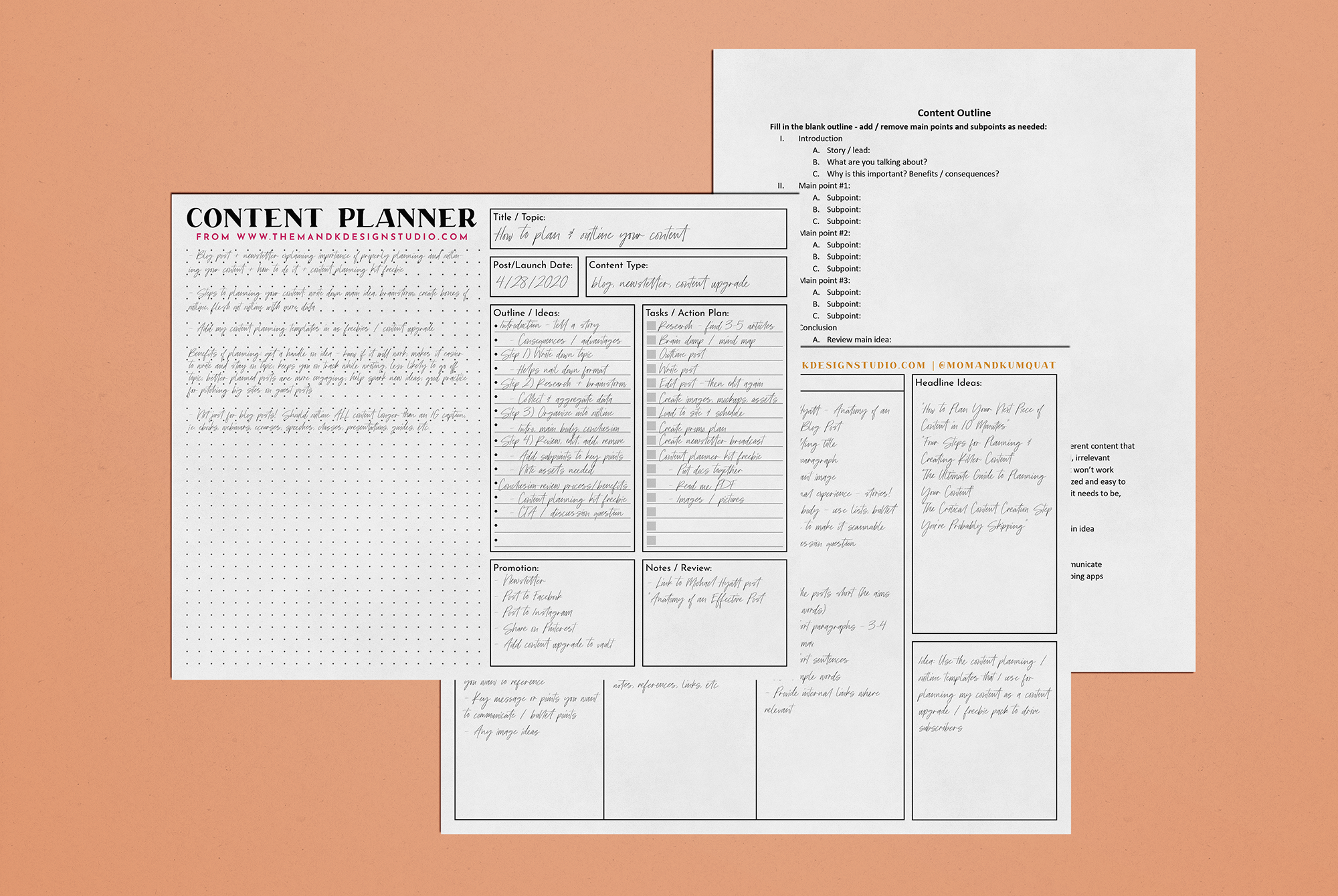The Critical Content Creation Step You're Probably Skipping
Writing without planning is an amateur mistake
There, I said it. Writing your blog posts, ebooks, webinars and other content without creating an outline first is like trying to bake a cake for the first time without a recipe. Or trying to make a pie without a crust. Or attempting to bake cookies without flour (or an appropriate gluten-free substitute, if that's your thing).
Is it possible? Sure. Maybe. But is it a good idea? Likely to turn out well? Probably not. (But seriously, is anyone else craving baked goods???)
Without an outline, your content doesn't know where to go. At best, you'll create otherwise great content that's unorganized or lacks key info. At worst, the content wanders completely off track, gets lost in the weeds, and ends up so incoherent that your readers click the big red X just to get away from it. You may even get halfway through writing it, just to realize it's not going to work.
In other words, failing to plan your content means planning to write sucky content.
And here's the thing: if your content sucks, your marketing will suffer. Your customers will look elsewhere, and your business will fail.
Outlining is like Google mapping your content. It organizes your post and makes it easier to understand - plus, you're less likely to forget key points (no Prevagen needed). Well organized + easy to understand = higher reader engagement + better SEO.
How to outline your posts, ebooks, & other content
Planning your blog posts and other content doesn't have to be a fancy, convoluted process - you can do it in a few simple steps. Ten minutes invested in planning now saves you time down the road in the writing and editing phases, and reduces (or maybe even eliminates) writer's block. It also drastically improves your writing - which leads to more readers, more conversions, and more $$$.
Failing to plan your content may be an amateur mistake, but creating your own planning and outlining process is easy-peasy-lemon-squeezy - check out mine below to get you started. I can't promise "one million likes and subscribers" as Kumquat likes to say, but I can promise that your writing will improve by, like, a lot.
Step #1: Write down your topic or main idea
It doesn't have to be in perfect headline format yet - just get the main idea out there on paper (or screen). This helps pin down your subject area and post format - a list, a how-to guide, review, etc. It's also a good idea to note any thoughts you might have on your lead (the first few sentences of your post or content).
Step #2: Do your research
It's always a good idea to do a little research before you sit down to write. You don't want to be that person providing 2006 information in the year 2020. I make it a point to review at least 3-5 recent articles on the subject I want to write about.
Research sparks new ideas and information and provides insight into whether the topic you've chosen is resonating with your audience. Note the URLs for any posts you want to reference, or grab the embed code for social posts.
Step #3: Brain shit all over the place
After you've read up on your topic, grab some paper or a fresh document (or check out my handy planning kit here) and start brain dumping every single thought you have relevant to your topic. Don't censor yourself or worry about organization yet - the point is to collect as much information as possible. You can whittle things down in the next step.
I use a dot grid page for this - I like to include drawings, doodles and diagrams, especially if I have a brilliant idea for a freebie or worksheet (and if I'm being honest, sometimes I just like to doodle). You can also do it the old fashioned way on a blank page, type it into a Google Doc, or use a mind mapping app like MindNode.
Do it: Got an idea for a blog post buzzing around your head? Take five minutes now to write down every thought or piece of info you have. While you're at it, I dare you to doodle your best poop emoji.
Step #4: Organize those thoughts into an outline
Type A peeps, rejoice - we're at the organization stage. Start by reviewing your brainstorm and highlighting or starring the most important information, then make notes of what sub-thoughts belong where, and nix anything that's not utterly vital to your main idea.
Once you've reviewed your brainstorm, it's time to refashion it into the bones of your post. The exact format will depend on the type of content you're producing, but typically, an outline should consist of:
Introduction: Your lead. Try to answer the questions "what am I talking about, and why is it important?" right off the bat, but keep it broad - you'll get into the nitty gritty later. Blogging "best practices" right now suggest including a story in your lead, but it's not 100% necessary. (Check out this article from Lean Labs for more on writing a killer intro.)
Main content: The organization here will depend on the format of your content, but typically this should be a few key points in support of the idea in your lead. Main points should be the subheadings, and each subheading should have a few facts / thoughts to support it. Use the information you gathered in the research phase to fill this in.
Conclusion: The "happily ever after". Review your main idea and supporting points, point out to your reader that they now have the info they need to avoid being eaten by sharks while scuba diving in Mexico, and issue your call to action.
Step #5: Review outline and add more info as needed
Review your outline and brainstorm sheet - add in your reference links, make note of images or assets you need (i.e. photos or content upgrades) and flesh out your main points with supporting data.
Now get writing!
Your outline keeps you on track as you tackle the task of actually writing your content - and makes writing it fifty hundred million times easier (I love the way Kumquat counts!). An effective outline keeps you on topic, organizes your content in a clear and concise way, and ultimately increases reader engagement.
Save yourself even more time by creating a content planning template to help you brainstorm and outline your blog and other content on the fly. Or, just steal my content planning kit for free here, and stay tuned for a future post about how I use Trello to plan my editorial calendar (subscribing is the best way to do that!).
Do you plan and outline your content? Or do you sit down at your computer 12 hours before it's due and wing it? Share your process (or lack thereof) in the comments, and let me know if you have any questions about planning and outlining your blog posts, ebooks, webinars and other content.



